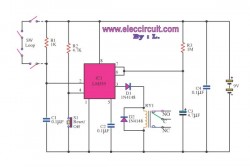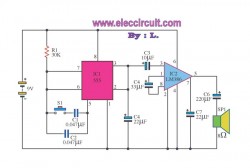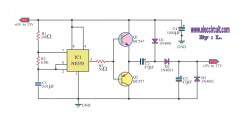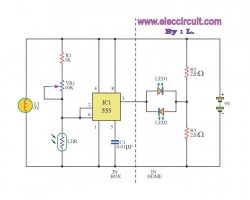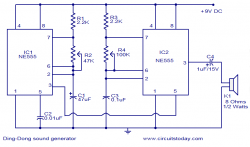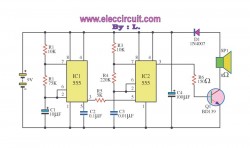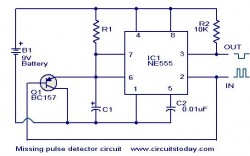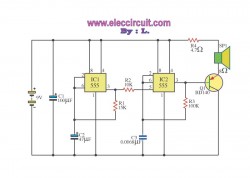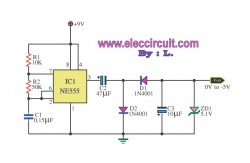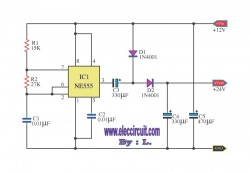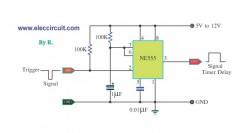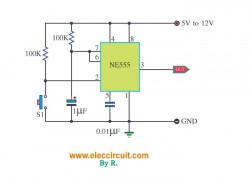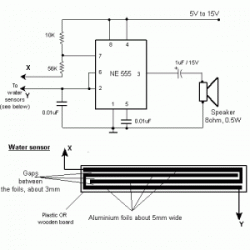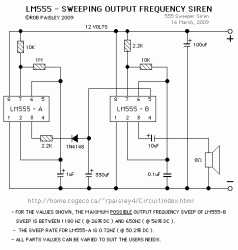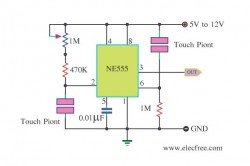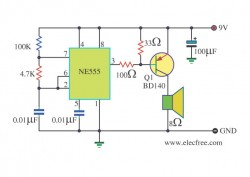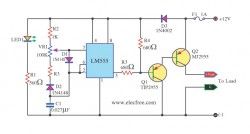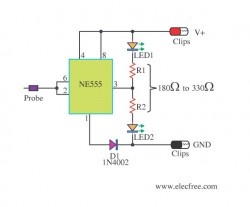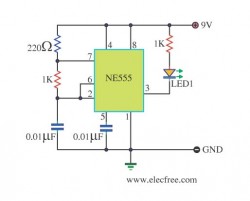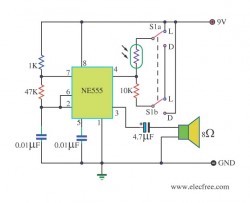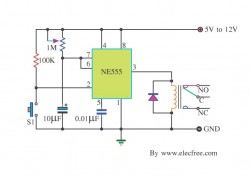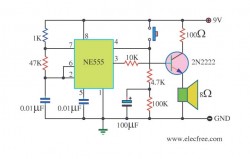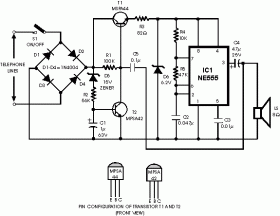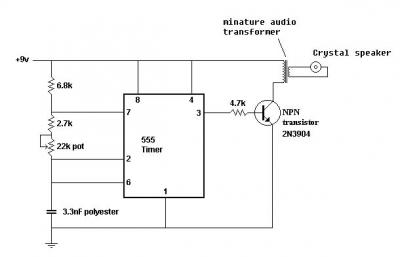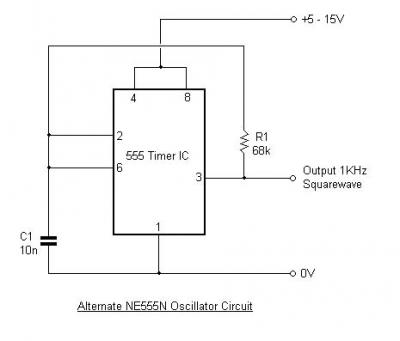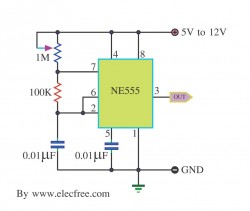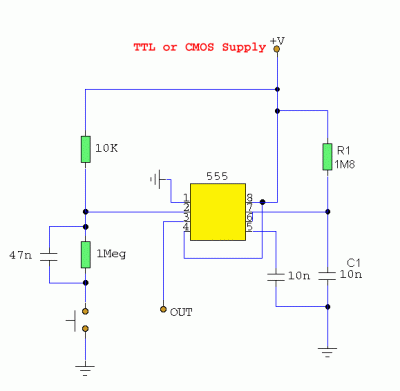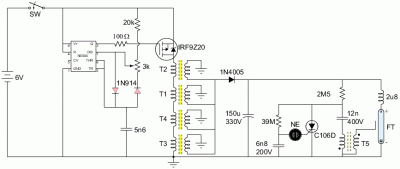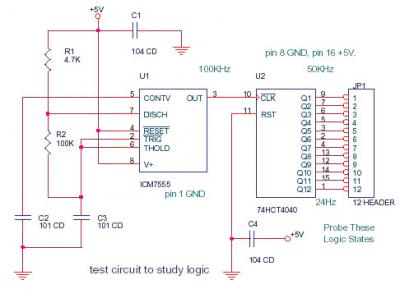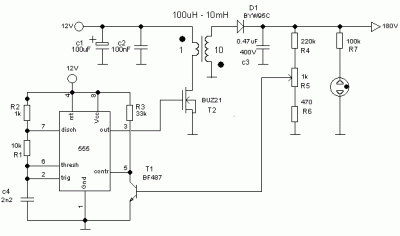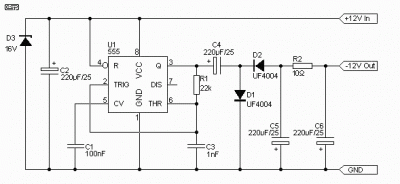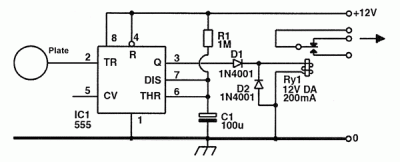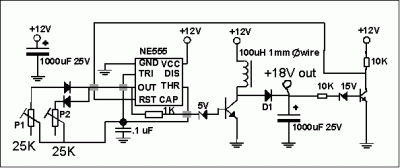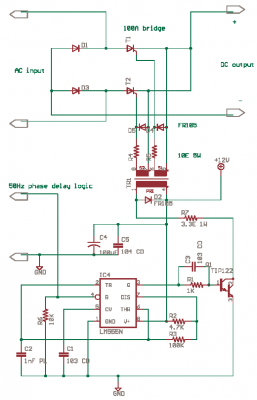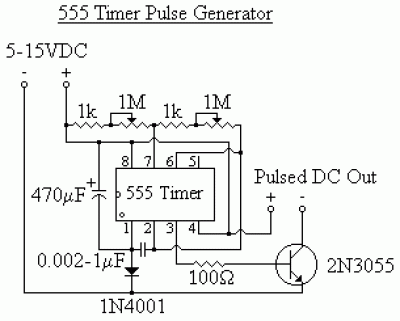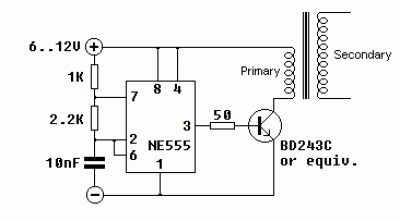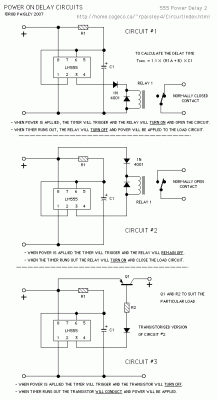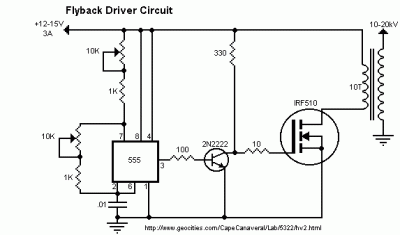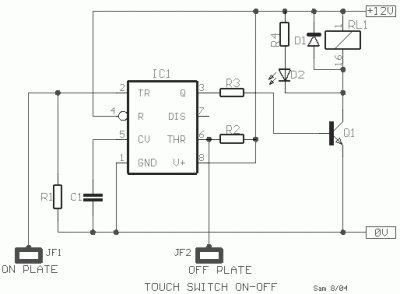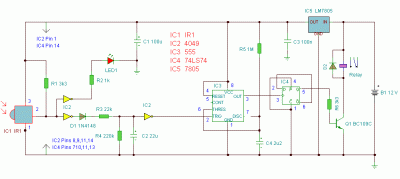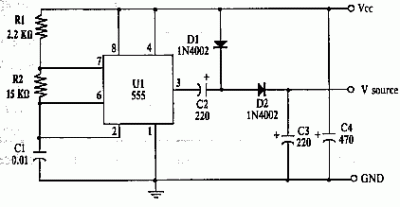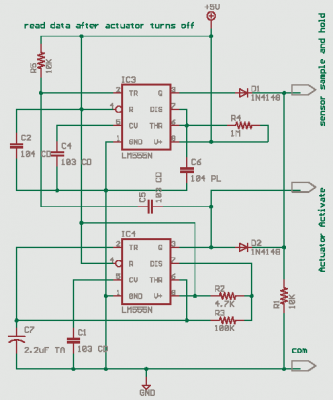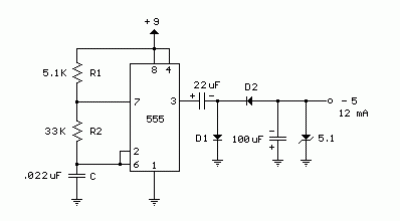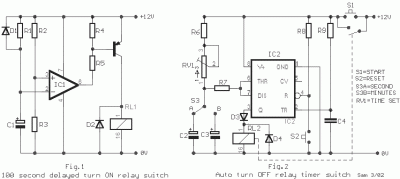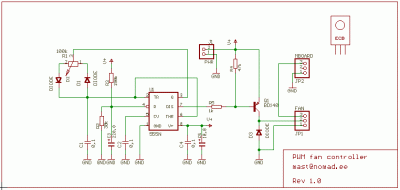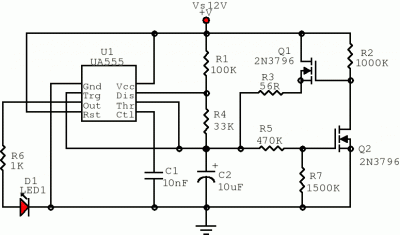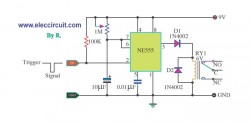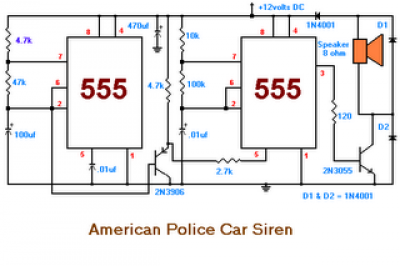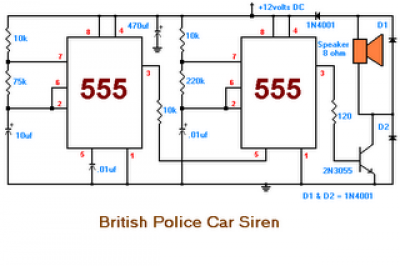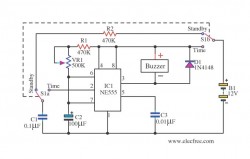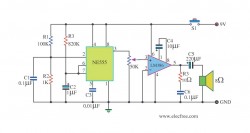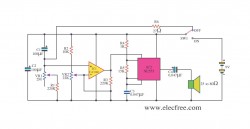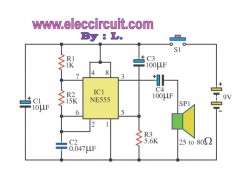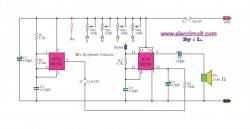Alarm sound with control switch.
The heart of this circuit is IC No. 555. When the alert sound was working, even though the switch will continue to be the same, the sound still does not stop immediately.But it will stops automatically, when a set time period,Depending on the resistance of R3, the circuit so I set a time period equal to 1M for 1 minute 6 seconds.
The output of IC 555 is triggered by a positive voltage on pin 2,when all switches are connected together.When the something switch is cut off pin 2, it will be negative voltage and the trigger IC 555 will stop. The C1, C4 to protects a noise signal from either switch, which may cause the alarm to be up. This circuit can be used with power supply from 5V to 15V depending on relay sure enough.
Courtesy Light by 7555 or TS555CN
15 seconds delayed switch-off, A good idea for bedroom lamps
This circuit is intended to let the user turn off a lamp by means of a switch placed far from bed, allowing him enough time to lie down before the lamp really switches off. Obviously, users will be able to find different applications for this circuit in order to suit their needs.
Parts :
R1 = 470R 1/2W
R2 = 100K
R3 = 1M5
R4 = 1K
C1 = 330nF-400V
C2 = 100µF-25V
C3 = 10nF-63V
C4 = 10µF-25V
C5 = 10nF-63V
D1 = 1N4007
D2 = 1N4007
D3 = BZX79C10
D4 = TIC206M
Q1 = BC557
IC1 = 7555 or TS555CN CMos Timer IC
SW1 = SPST Mains suited Switch
Circuit operation:
Due to the low current drawing, the circuit can be supplied from 230Vac mains without a transformer. Supply voltage is reduced to 10Vdc by means of C1 reactance, a two diode rectifier cell D1 & D2 and Zener diode D3. IC1 is a CMos 555 timer wired as a monostable, providing 15 seconds on-time set by R3 & C4. When SW1 is closed, IC1 output (pin 3) is permanently on, driving Triac D4 which in turn feeds the lamp. Opening SW1 operates the monostable and, after 15 seconds, pin 3 of IC1 goes low switching off the lamp
Noise generator 2 frequency with ic 555
Operation of the circuit is when the power supply to the circuit. It will give birth to high frequency by using a circuit IC1 to a multi-state Devices Bill Brett Foster. The frequency with which R1, C1 and C2. The frequency will be out in three legs. And will be expanded with the IC2 output pin out of 5 in order to drive the speakers. The high-frequency sound. But when the switch S1, capacitor.
C1, which continue to cycle in a manner parallel to the C2 value higher density. IC1 will give birth to low-frequency out of pin 3 to IC2 then drive the speakers. This circuit can cause the audio source has two frequency
dc to dc converter using ic ne555
When the power supply input to IC1 is the output pin 3 at a frequency of 1 kHz.The frequency is Q1 and Q2, which will continue to use push pool work interchangeably.If this is the positive output signal Q1 Q2 will run the delete function this reason, C2 and C3 capacitors are half-wave alternating.
When to use. Voltage from C2 to C3 is discharged out to the input voltage over almost two times less than 2 times due to the loss of diodes D1-D3
Electronic mailbox front door with ic 555
For example, this circuit. It gives us no time to wait to check voice mailbox.We see the LED is just enough.
Operation of the circuit. While no letter LDR will receive light from the lamp. The LDR resistance is very low. Resulting in IC does not work.
There is no output from the 3 pin. It make the current flows through R2, LED2 into three legs of IC1.The light LED2.But when a letter in the mail box to shield the light from the lamp. The LDR is not light. LDR will be much resistance.Voltage drop across the LDR is high enough to make IC1 work.
IC1 to produce frequencies from 3 pin. The light LED1
Negative supply voltage low current
Work of the circuit is IC1, R1, R2 and C1. The range of the A Stable Multi Vibrator, and the output is a square wave. It is a positive signal pulse frequency of 2.3 kHz output pin 3 of IC1.And C3 and D1 connected to circuit CLAMP. That it serves to signal a positive pulse to pulse signal negative.The D2 and C3 act negative pulse signal is converted direct current (DCV) electrical signals. The negative power. Thus the output voltage to a negative DC electrical
Ding-Dong sound generator by NE555
Police sirens sound with ic 555
The work of the circuit IC1 which build be astable multi vibrator circuit. Will signal frequency low origin comes out the way pin 3 have about 1 Hz by frequency value that s were fixed by the value , R1, R2, C1 signal the frequency will have that to come out pin 3 ways which built get along well with 5 of IC2 change R5 . By the frequency from IC1 will touch total up with the frequency at IC2 establish will valuable about 440 Hz – 550 Hz the frequency had that to sent come out pin 3 ways. Which be take gush up of IC2 the connection goes to get along well with B of Q1 for enlarge the trend comes to sing bail make the sound of the circuit that comes out resemble the sound of police siren
Missing pulse detector circuit using NE555
An NE555 timer IC connected as shown here can detect a missing pulse or abnormally long period between two consecutive pulses in a train of pulses,Such circuits can be used to detect the intermittent firing of the spark plug of an automobile or to monitor the heart beat of a sick patient.
The signal from the pick up transducer is shaped to form a negative going pulse and is applied to pin 2 of the IC which is connected as a mono stable.As long as the spacing between the pulse is less than the timing interval,the timing cycle is continuously reset by the input pulses and the capacitor is discharged via T1.A decrease in pulse frequency or a missing pulse permits completion of time interval which causes a change in the output levelTwo sirens sound with ic 555
9V battery changed to -5V
By using IC NE555, which causes wave square the sector output allows the voltage about 6V when the signal on the output from a pulse plus C2 acts charge through D1 to ground and if the pulse negative capacitor C2 will discharge. through diode D1 and capacitor C3 to chage that negative voltage is about-6V, but being removed to the number of left-5V zener diode ZD1 current output will be approximately 12mA
Doubler voltage 12vdc to 24vdc with NE555
This be Simple Doubler Voltage circuit, from voltage 12VDC to be 24VDC. By use Timer IC highly popular the number NE555 and other equipment a little again. It can give current get about 50mA convenient for the circuit, that use low current the small-sized.
The principle works of the circuit be, When use Volt input 12VDC give with the circuit will touch Filter current smoothly with increasingly. The capacitors C5 give with IC1, The resistor R1,R2 and , capacitors C1, Which build the circuit model astable multi vibrator Square wave generator, at the frequency about 2KHz come out the way pin 3 of IC1. By have capacitors C3,C4 diode D1 and D2. Which build be boost up voltage x 2,which will enhance the level Volt out be the direct current about 24VDC or 2 times of the level Volt inputOne – Shot Timer use IC NE555
This is digital circuit, It is One – Shot Timer make by IC 555.
Power supply 5-15V, Output pin 3, Input pin 2 Trigger input.
T = 1.1 RC
Bounceless switch using IC NE555
This is circuit Bounceless Switch ,
Use IC 555 Timer for Easy Timer circuit.
Output pin 3 pluse 0.1s. Control by push S1.
Volt supply pin 8 = 12Volt
Rain Alarm using NE555
The sensor is also shown in the circuit diagram. It has to placed making an angle of about 30 – 45 degrees to the ground. This makes the rain water to flow through it to the ground and prevents the alarm from going on due to the stored water on the sensor
Water Softener Circuit using NE555
Sweeping Output Frequency Siren
Electronic Time Constant Control
The advantage of using this type of frequency control is that the duty cycle of the timer is not affected when the frequency is changed
Touch Switch low cost by Timer IC 555
Danger Beep by IC 555
Spot lamp dimmer by LM555 and TIP2955
Positive Negative Probe with IC 555
LED Tone Generator by IC LM555
Light Dark Detector Alarm by IC 555
Today we come to see the circuit detects the light by have a voice warn. When meet the light or be become dark depend on using S1 ( follow the circuit ). For this my circuit uses the integrated circuit IC 555 be pillar equipment again. You can choose can use many the number be LM555 or NE555 or use the number instead of eat the low beam be IC 7555 all right. For that circuit when S1 stay in a position . And there is the light shines at LDR (Photoresistor) a loudspeaker will utter. When S1 stay in a position and have no the light at LDR loudspeaker utter also. This easy good circuit friends may have fun IC 555 detector light this please sir.
Basic Timer Control with NE555
Tone Burst Generator by LM555
DC to AC Inverter by IC 555 and TIP41 TIP42
This be basic AC inverter Circuit. Convenient for the initiator who have to is extremely fond of something experience. Because of use IC 555 highly popular, perform produce the frequency ,then enlarge with transistor NPN and PNP number TIP41 and TIP42 drive the coil transformer. Get by can pay Voltage output about 120V to 230V at frequency 50Hz. By have R4 perform control the frequency and should use. Voltage supply about 5V to 15V the detail sees in circuit picture sir.
Watch-Dog for Telephones by NE555
Universal IR Controller for a PC by 74LS74,555
Annoying high pitch noise generator by 555
The circuit can be mounted in a plastic box like I have done. The good thing about high frequency sounds is that it is very hard to find where they are coming from. Also, the noise is very annoying and irritating. The crystal speaker is the creamy coloured thing at the bottom of the photo on the left
Alternate 555 Oscillator
This is a slightly simpler circuit than the one above. The circuit uses just one resistor and one capacitor with the 555 timer IC to create a stable and reliable oscillator with an output that it a true squarewave.
The formula for calculating the frequency is:
f=1/(1.4*R*C).
The values in the formula are expressed in ohms, farads, seconds and hertz. This formula is much simpler than that of the previous circuit. With the values shown on the circuit, the frequency is calculated as 1050Hz, but like the previous circuit, this arrangement can operate at frequencies up to around 500kHzBasic 555 Timer Oscillator
The circuit on the left shows the standard astable oscillator circuit for the NE555N IC. This si the basic circuit that is shown in most component catalogues and other sources of 555 IC information. With the components shown on the diagram, the output frequency will be approximately 1kHz and the duty cycle 50-50.
…
Simple Pulse Generator by IC 555 Timer
Use for digital Logic circuit. IC 555 use voltage supply 5V to 15V.
The output’s frequency is control by R1.
Detail more, Please read in this image circuit
4017 Led Pattern-Flasher
PBS Switch Debouncing by 555
This circuit will remove the transient spikes and contact bounces from a non-latching push button switch.
Using a 555 timer as a monostable circuit, it is easy to build a good switch debouncer circuit. There are many circuits for SPDT debouncing, but not many for a normally open, push-to-make press button switch (PBS). The 555 monostable gives an output pulse of around 20 msec with component values shown. The formula for determining the output pulse is:
tout = 1.1 R1 C1
3-6V Xenon Strobe Light by IC 555 and IRF9Z20
The 555 is set up as a pulse width modulator (the off (low) time being set by the trimmer). The output at pin 3 is connected to the gate of the P-channel MOSFET (IRF9Z20) through the 100R resistor to prevent parasitic oscillation of the transistor. A low signal at pin 3 causes the MOSFET to turn on, thus the potentiometer controls the output power, and somewhat the flash frequency, by varying the duty cycle of the 555 and in turn the MOSFET
Frequency Divider by 555 and 4040
U1 7555 is a CMOS version of 555 LM555 pdf datasheet.
The 555 here is in Astable Oscillator mode, C1 and C4 are decoupling capacitors 0.1uF value, ceramic disc.
The output is around 100kHz, If C3 is plastic or mica the frequency output will be stable with temperature. It is better to use a crystal oscillator.
The 555 output is fed to clock input of 4040, the output of 555 will be a square wave, on every high to low transition (falling edge or negative transition) the counter increments by one and the output is 12 bit binary.
If input frequency is F the final output at Q12 is F/4096. The period T = 1/F.
If you make the 555 run at 1Hz, C3 around 7uF, Then this circuit becomes a long duration timer, the Q12 period will be 4096 seconds or 68 minutes
A flyback converter high voltage supply by 555
12VDC Negative Voltage DC Converter by 555
The circuit is very simple, and is easily made on Veroboard or similar. Construction is not critical, and the schematic is shown in Figure 1 below.
Rectifier diodes should be ultrafast (UF4004 or similar), or you can use 1N4148 signal diodes. Losses will be slightly higher if you use signal diodes, or lower if you wanted to go to the trouble of using Schottky diodes – the latter are not warranted in such a simple circuit (IMO). The zener diode is to protect the circuit against transient overvoltage, and is optional
Using only a standard NE555 timer and a few other parts, this circuit should be up an running in about an hour. The 555 is configured as a minimum parts count astable (i.e. no stable states) multivibrator, and runs at around 17kHz with the values shown. The zener diode (D3) should be a 16V/ 1W type. Resistors are 1/2W carbon film, and small caps may be polyester or mylar
100 Seconds Duration On Switch with Touch Control by 555
This is a touch control switch which keeps the circuit on about 100 seconds after touching the plate connected to the 2 numbered pin. At the end of this time duration, relay releases and the circuit gets to off position.
The impedance of the trigger input of the 555 timer IC is very high and the inductive voltage on the human body is enough to trigger it. The circuit works based on this principle. You can use a piece of metal as a plate. The circuit can be used in toy circuits, buzzers or any project that is suitable. You can adjust the duration time by changing the R1 and C1 values12V to 18V step-up DC converter by IC 555
This is a power source that creates a DC voltage higher than the voltage feeding the it. It might be used to power your laptop (+18V) from a car battery (12V ~ 13.8V). It is built using very ordinary parts that should be readily available. Here are some specs:
Input voltage 9V ~ 15V
Output voltage 12V ~ 25V
Output current Max. 3A @18V
Switching frequency 20kHz – 40kHz
Efficiency 65% – 95%
If you know these circuits, please skip the following. The circuit is a step-up converter, and it’s workings can be explained by the main property of a coil: its inductance. Imagine a current flowing through a coil. The inductance will cause the current to continue running, even if the power supply that caused this current is taken away. The voltage across the coil will take any value required to keep the current running. This is why you can easily create sparks with a coil, a spark is simply a current flowing at a very high voltage.
This circuit flips between two states: ‘charging’ the coil with current, and dumping this current into the output capacitor. The frequency at which this happens is so high that only a small ripple remains at the output capacitor (10000uF). Here is the circuitDrive SCR thyristor by IC 555
This circuit gives a burst of pulses to fire 2 SCRs, when pin 4 is taken to 12V the SCR is turned on, to use this circuit you need 12V short pulses phase shifted with respect to AC sine wave on bridge.
This way you can control the bridge from near 0% to near 100% ON, that way battery banks can be charged, electroplating can be done, current and voltage can be controlled with opamps, thyristors are very rugged compared to transistors and MOSFETS in that order555 timer pulse generator
To drive ignition coils is to use a 555 timer pulse generator. A 555 generates a square wave output that triggers the 2N3055. Adjusting the two potentiometers and the value of the capacitor will change the frequency of the output.
Flyback Transformer Based high voltage generators
12V input, 12V battery charger by 555,7815
The charger consists of two stages: The first is a capacitive voltage doubler, which uses a 555 timer IC driving a pair of transistors
connected as emitter followers, which in turn drive the voltage doubler proper. The doubler has power resistors built in, which limit the charging current.
![]()
The second stage is a voltage regulator, using a 7815 regulator IC. Its output is applied to the battery via a diode, which prevents reverse current and also lowers the voltage a bit. The resulting charge voltage is about 14.4V, which is fine for charging a gelled or AGM battery to full charge, but is too high as a trickle charger, so don’t leave this charger permanently connected to a battery. If you would like to do just that, then add a second diode in series with D3!
There is a LED connected as a charge indicator. It will light when the charge current is higher than about 150mA. The maximum charge current will be roughly 400mASOLID STATE TESLA COIL WITH 555 TIMER
Ignition coil driver by IC 555 + 2N3055
Power On Delay Circuits by 555
These circuits will delay the application of power to a second circuit using mechanical relays or transistors. Other output control devices could also be used.
Efficient flyback driver by IC 555 + IRF510
Touch Switch ON-OFF by IC 555
The modern mechanic switches are improved concerning of old technology. We need however many times to replacement some old switch or to check currents bigger than the durability of certain switches or simple we need something with modern appearance. For he and different reasons is essential the up circuit. He is simple in the manufacture and the materials that use they exist everywhere. This based in the known 555, which drives a relay of which the contacts play the role of switch. The metal surfaces can have what form we want, but it should they are clean and near in the circuit. In order to it changes situation it suffices touch soft somebody from the two plates. Plate JF1 in order to the contacts of RL1 close [ON] or plate JF2 in order to the contacts of RL1 open [OFF]. The current that RL1 will check depended from his contacts. The Led D2 turns on when the switch they are in place ON and the contacts of RL1 closed.
Part List
R1-2=3.3M 1/4W 5% D1=1N4148 RL1=12V Relay [Your choise ]
R3=10K 1/4W 5% D2= Red LED 3 or 5mm. JF1-2=Metal Plate
R4=1K 1/4W 5% Q1=BC547
C1=10nF 63V MKT 5% IC1=555
Infrared Remote Control System Receiver
Infrared Remote Control System Receiver By IC Digital
This is a single channel (on / off) universal switch that may be used with any Infra Red remote control that uses wavelengths between 850-950nm.
Notes:
Any “button” of any remote control may be used to work this universal switch. The button must be pressed for two seconds (determined by R3 and C2) before the relay will operate. Once operated the circuit will remain in this state (latched) until reset. To reset, any button is pressed and held for the delay.
For example, if you were watching TV, and your set was tuned to Channel 3, you could press and hold the TV remote controls channel 3 button for two seconds. That way the TV viewing would not be affected and the relay would activate. You can connect anything to the relay, for example a lamp, but make sure that the relay contacts can handle the rated voltage and current.
IC1 is an Infra Red module. IR modulated pulses are received and buffered by this IC. It has a standard TTL output, the output with no signal is logic 1. One gate of a CMOS inverter and drives Red LED1 as a visible switching aid. Another gate buffers the signal and applies it to the time constant circuit, comprising R3,C2,R4 and D1. C2 charges via R3, and discharges via R4, D1 prevents quick discharge via the low output impedance of the CMOS buffer
Voltage doubler with IC 555
parts:
U1 NE555 timer IC
R1 2.2k ohm resistor
R2 15k ohm resistor
C1 0.01 uF ceramic capacitor
C2, C3 220 uF electrolytic capacitor
C4 470 uF electrolytic capacitor
D1, D2 1N4002 diode
all resistors are 5 or 10 percent tolerance, 1/4-watt
all capacitors are 10 percent tolerance
Nagative voltage generation using 555 timer
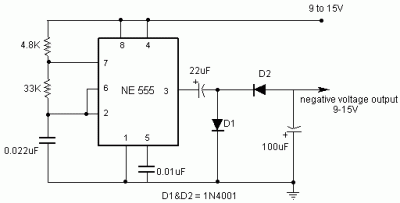
This is Circuit build Nagative voltage generation Form IC 555 timer ,It is Hot IC and Easy to Use
OR gate with two IC 555
Generating -5 Volts From a 9 Volt Battery With IC 555
Relay Timer switch By IC 555 and 741
In Fig.1 see a 100 second delayed turn ON relay RL1 switch, if plug power +12V in circuit. In Fig.2 see a two range 6-60 second and 1-10 minute auto turn off relay timer circuit, with 555.
Part
R1=1 Mohms C4=100nF 63V IC2=LM555
R2=330 Kohms C1-2=100uF 16V RV1=470 Kohms pot.
R3=680 ohms C3=1000uF 16V RL1-2=12V >120 ohms Relay
R4=2.2 Kohms D1=1N4148 S1-2=Push button n.o
R5-7=4.7 Kohms D2-3-4=1N4001 S3=2X2 switch
R6=47 Kohms Q1=BC214
R8-9=22 Kohms IC1=LM741
lead acid battery Charger 6V -12V By 555 and LM340
I use IC 555 and LM340. Read Detail more in image circuit
PWM Speed Motor Controller By IC 555
This 555 timer based PWM controller features almost 0..100%
This 555 timer based PWM controller features almost 0..100% pulse width regulation using R1,while keeping the oscillator frequency relatively stable. The frequency is dependent on values of R1 and C1,
values shown will give a frequency range from about 170 to 200 Hz. Any 555 chip will do, CMOS is fine as well.
Diodes are not critical, I used 1N4148. Total cost of parts is about $2. As the whole thing is quite trivial,
it’s very easy to build on prototyping board like I did (as you can see, one of capacitors –
C1 is replaced with different value, 0.047 uF to be precise
Inverts to Negative From Positive Voltage by IC 555
This simple circuit is a good solution to the powering a dual supply op amp from a single battery problem. The circuit simply takes a positive voltage and inverts it. It uses only one 555 timer and a few other passive components, so it doesn’t add much in the way of size and cost to a project.
Substitutions
R1 1 24K 1/4 Watt Resistor
R2 1 56K 1/4 Watt Resistor
C1 1 3300pF 25V Ceramic Capacitor
C2 1 47uF 25V Electrolytic Capacitor
C3 1 10uF 25V Electrolytic Capacitor
D1, D2 2 1N4148 Silicon Diode
U1 1 555 Timer
MISC 1 Wire, Board
IC Digital 555 Pulse Generator
Circuit : Miroslav Adzic – Serbia & Montenegro
Description:
A 555 pulse generator circuit with a difference, the initial pulse is tailored by additional circuitry to match the duration of subsequent pulses.
single pulse gen
Notes:
The NE555 and the First Pulse
Timer Plus Relay by IC 555
This be Timer Plus Relay Circuit by IC 555. When see the circuit also a little equipment. By the value R1 and C1 perform set the time give Relay work 11 long ago second. When we begin to encourage the circuit by switch press 2 pin with a leg Ground note: Relay 6V 500ohm. Use current 12mA. The detail is other , see in the circuit adds.
Red Alert Startrek Alarm by IC 555
The third circuit simulates the Red Alert siren from the TV show Star Trek. It uses two 555 timers in the circuit. The 555 on the right is wired as an alarm tone generator and the second 555 timer on the left is wired as a 1.5 second non-symmetrical astable that generates a fast rising but slow falling saw tooth waveform. This waveform is buffered by the transistor and used to frequency modulate the tone generator and making its frequency rise slowly during the falling parts of the saw tooth but collapse rapidly during the rising part of the saw tooth. The output starts as a low frequency, rises for 1.15 seconds to a high tone, ceases for .35 seconds and then repeats the cycle.
American Police Car Siren by IC 555
The second circuit simulates the siren of an American police car. It uses two 555 timers in the circuit. The 555 on the right is wired as an alarm tone generator and the second 555 timer on the left is wired as a low frequency astable timer which generates a ramp waveform of about 6 seconds that is buffered by the transistor and again used to frequency modulate the tone generator. The transistor is used to help strengthen the signal to the speaker
British Police Car Siren by IC 555
This month I am making 3 different types of siren circuits based on the 555 timer. The first circuit simulates the siren of a British police car. It uses two 555 timers in the circuit. The 555 on the right is wired as an alarm tone generator and the second 555 timer on the left is a 1 Hz astable multivibrater. The output of the left timer is to frequency modulate the right timer. This causes the right timers frequency to alternate between 440Hz and 550Hz at a 1 Hz cyclic rate. The transistor is used to help strengthen the signal to the speaker.
Circuit Egg Timer By LM555
This is Easy and Mini Timer Circuit ( Egg Timer) by IC 555.
Alarm by Buzzer.
Circuit Door Buzzer by NE555 + LM386
Someday I goes to visit a friend. He begs me helps to seek electric bell front door circuit. In model to be simple, use the a little equipment. I then choose the Door Buzzer circuit this give. Because of use , IC NE555 produce electric bell sound and use IC LM386 for amplify talk at one time. For R1 use fine decorate the sound as you like it. request have fun this circuit.
Table Lamp Circuit by IC 555
If you want Power Lamp Flasher at give electric tall power. As a result try out Table Lamp Circuit the this. It uses the integrated circuit NE555 be pillar equipment. Control the rate blinks of Lamp. Get , for the transistor power make Lamp 12V electric tall power about 20W or use current 1.6A stick bright get. The Q3 can use replace get many the number such as TIP41 or H1061 or MJ3055 or will use 2N3055 numbers all right sir. The detail is other see in the circuit
LED Chaser by IC 4017 + IC 555
I believes in that extremely amateur electronics many you, may ever build the LED flasher or light blinks or the LED Chaser prevent come to already. Today I begs for to advise the circuit LED Chaser, by have LED show 10 amounts together. blink stick bright chase go to continually. By have IC 4017 precede at drive a tube LED all. Which its work be Counter circuit good just this besides. Still have IC 555 wait for feed Clock with then can fine the speed of the winking with VR1 good easy. The detail is other see in circuit picture better.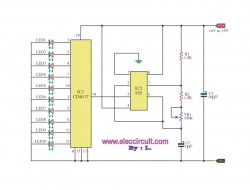
Circuit LED Chaser by IC 4017 + IC 555
Simple Timer by CA3140 + NE555
Door buzzer with 555
This is easy circuit buzzer. It use IC 555, Speaker 25 -80 OHM.
I demolishes a store-room , see old loudspeaker and other equipment a little again. Then born the though builds Door Buzzer by use , IC 555. Perform sound electric bell origin. When press S1 as a result have a voice fair loud. This circuit almost must not do anything. Because divisible Amen! should use 25-80ohm size loudspeakers. will make good sound use force against electricity low work or economize the electricity. You will may use 9V batteries all right sirIC 555 LED Flasher
This is easy LED Flasher circuit. It use IC 555 drive LED display.
A younger brother of me just begin take an interest the electronics. Want to try build Simple LED Flasher Circuit. I then advise this circuit , because of use the integrated circuit timer highly popular type IC NE555 or LM555 very the circuit is Pulse Oscilator the frequency is low. From the circuit will think to use LED 2 pcs wink alternate. Detail , have no chicken many mites. Invite a friend sees in circuit picture better sirSingle IC Organ By IC NE556
Single IC Organ By IC NE556
When you will think to build Single IC Organ Circuit the some one. I begs for to advise this circuit , because use IC NE556 or LM556. Which within its structure is like have the integrated circuit IC 555 arrive at 2 together follow my circuit. Control by Keyboard contacts and SW1 Tremolo ON/OFF as a result can choose music pitch that can want.The detail about mini Organ Circuit the this. Can see in circuit picture sir.
